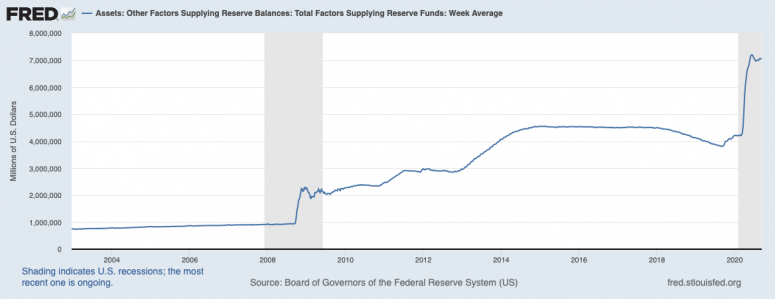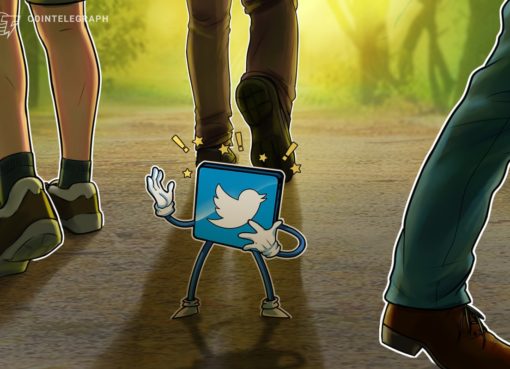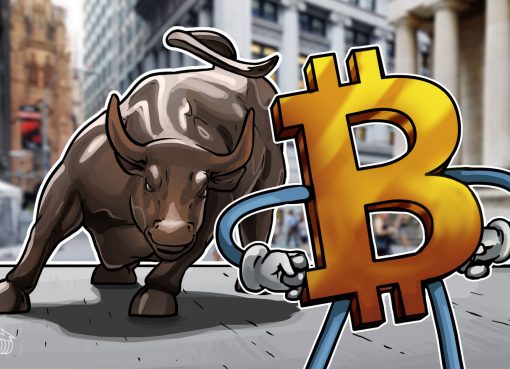Every time the Federal Reserve meets, it’s important to remember the only real monetary policy tradition at the 107-year-old institution is that a bunch of people will get together and talk about markets and the economy and decide what to do next.
There’s never really any right or wrong answer for how to go about it; there’s only the decisions the top Fed officials end up making. The officials are broadly guided, of course, by economic theory and history, ostensibly a desire to provide stability and long-term growth, and perhaps a bit of politics from time to time. But the ad hoc-ness of it all is underscored by the reality that the officials are constantly changing their own rules.
In terms of the market reaction, this week’s Fed meeting was as ho-hum as they come. The Standard & Poor’s 500 Index of large U.S. stocks slipped 0.5% on Wednesday as the central bank announced its latest incarnation of monetary policy. Gold was little changed. Bitcoin gained 2.2%.
That’s partly because Chair Jerome Powell had used a speech last month to telegraph his plans for a newly hatched technique known as “average inflation targeting.” Essentially, the Fed is now promising to keep U.S. interest rates close to zero until inflation climbs above a 2% target and stays there “for some time.” On Wednesday, the only real news was the officials formalized the practice.
Average inflation targeting hasn’t really ever been tried before, but Fed officials are now mostly in agreement it is the right thing to do at this point in time. The message they are sending is that investors, businesspeople and banks can count on the central bank to keep borrowing costs low until the economy heals.
“This could all go wrong under some future circumstances, at which point ‘Trust us, we’re the Fed’ might not be enough for the markets,” Ian Shepherdson, chief economist at the forecasting firm Pantheon Macroeconomics, wrote in a note to clients.
Just like the $1.2 trillion of Fed emergency-lending programs rolled out during the 2008 financial crisis, average inflation targeting is a brand-new tool that investors until recent times weren’t aware that the central bank might ever choose to use. And just like former Fed Chair Ben Bernanke’s “quantitative easing” programs in the years after the financial crisis, under which tens of billions of Treasury and mortgage bonds were purchased every month, the new policy is really just a way of trying to engineer an economic recovery.
“The creativity of monetary policy will remain high, there’s no question,” says Ben Emons, a former portfolio manager for the bond-fund giant Pimco who now serves as managing director of macro strategy for the analysis firm Medley Global Advisors.
What gets a little ridiculous is any attempt to drill down into the supporting materials provided by the Fed as the premise for the decision. A “summary of economic projections” posted online Wednesday shows top officials on average expect inflation to stay below 2% for the next couple years before hitting the mark in 2023. They expect the economy to shrink by 3.7% this year before expanding 4% next year, 3% the following year and 2.5% in 2023.
It’s the sort of picture one might expect from a perfectly managed economy.
But, of course, Fed officials have little more of a clue than anyone else what the future holds, even in the near term. One of the most contentious presidential elections in U.S. history looms in November. Racial tensions are on the rise. The course of the pandemic is far from settled. Lawmakers are at odds. The national debt has fast grown to nearly $27 trillion, up about $23 trillion at the start of the year, and there’s no realistic expectation that the federal budget will be balanced anytime soon.
The economic outlook, and the trajectory of markets, can change quickly. Unexpected things happen. In late 2019, Fed officials were predicting the economy would grow at an anemic but steady 2% clip in 2020. That didn’t happen. Fed officials really have no idea how the economy will fare through 2023, let alone what the next few months might bring.
Markets have been stable recently, if even a little frothy, and there’s no reason for the Fed to mount any particularly heroic effort right now to change that dynamic.
“They’re driving through the fog and they cannot see,” Emons said in a phone interview. “We’re coming a bit out of the fog now, but there’s still a lot of fog.”
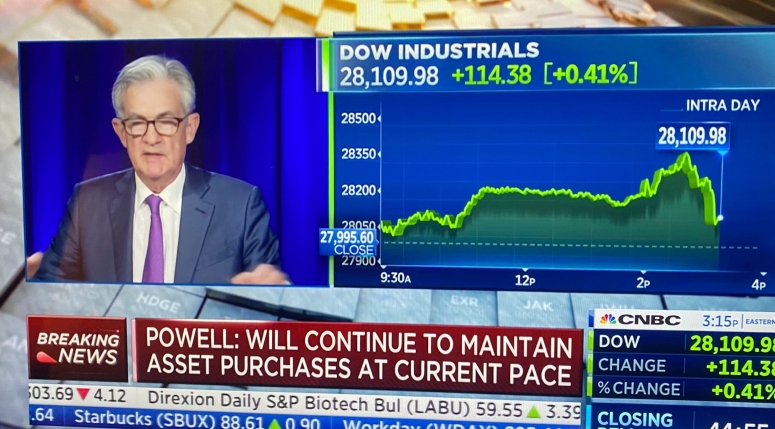
A plausible scenario is the Fed does as little as possible for the next several months unless markets take a fresh downturn, in which case it’s possible the Fed would intervene. When markets convulsed in March, the Fed in a matter of weeks expanded its balance sheet from about $4 trillion to $7 trillion; the increase represented about three-quarters of all the money the central bank had ever previously created. Until it happened, it seemed unthinkable.
On Wednesday, Powell was clear the Fed could act forcefully if needed. He noted the central bank is already buying $120 billion of Treasurys and mortgage bonds a month, which extrapolates to $1.44 trillion a year.
“I certainly would not say that we’re out of ammo, not at all,” Powell told reporters during a press conference on Wednesday. “There’s still plenty more that we can do.”
The lesson for bitcoin traders or gold traders or bond traders or any other investors trying to gauge the potential for rapid inflation or currency debasement, is that if Fed officials decide to print more money, they can and they will.
Bitcoin Watch
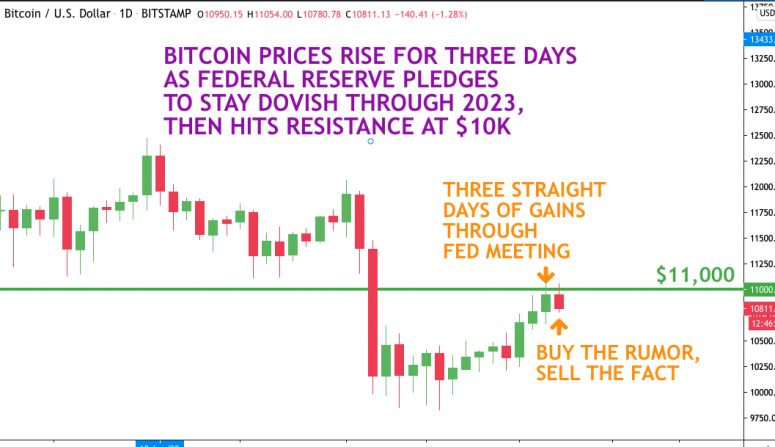
- CryptoX shows the bitcoin price corrected from a high of just under $11,100 to just under $10,900 in the Asia trading day.
- While the fall below such a key psychological hurdle is a blow to the bulls, bitcoin currently shows no signs of falling back to the $10,300-$10,400 range it traded at the start of the week.
- The correction in the bitcoin price might be a result of growing doubts over the Fed’s ability to hit the 2% inflation target.
- While the prospect of high inflation is generally considered to be good for bitcoin, some market observers have expressed concern over whether the Fed has what it takes to meet its target.
- Speaking to the Financial Times, John O’Connell, a portfolio manager at Garda Capital, said the Fed still had much to prove because it hadn’t been able to create inflation consistently for a very long time.
- Indeed, the Fed announcement was met with general uneasiness across the market. The S&P 500 slumped 0.46% and the Nasdaq fell a further 1%, while both bond yields and the U.S. dollar strengthened slightly.
- Similarly, an announcement from the Bank of Japan to keep rates unchanged this morning led to the Nikkei dropping 0.67% in the Asia trading day.
- While there’s a case for bitcoin benefiting in a deflationary market, it would certainly harm the prevailing narrative that the original cryptocurrency’s hard-capped supply makes it a perfect hedge against a runaway money supply.
- Bitcoin traded at $10,885 at press time. It may drop further as the Bank of England was also expected to keep rates unchanged later Wednesday.
Token Watch
Uniswap (UNI), SushiSwap (SUSHI), Ether (ETH): DeFi leader Uniswap mints 1 billion “governance tokens” to be released over next four years, a week after ” vampire mining” attack by copycat rival SushiSwap. The deal immediately started adding to congestionon the already-stressed Ethereum blockchain network, and the cryptocurrency exchange Coinbase has already listed the new UNI tokens on its pro platform. So has Binance.
Ether (ETH): Only 22% of options bets see ether over $400 next week at the Sept. 25 expiration.
Polkadot (DOT): Token-minting system Polimec could drive more people and projects onto Polkadot’s parachains.


